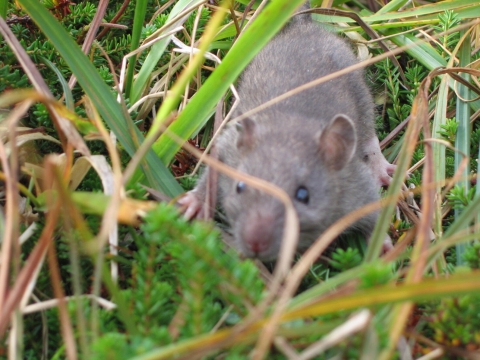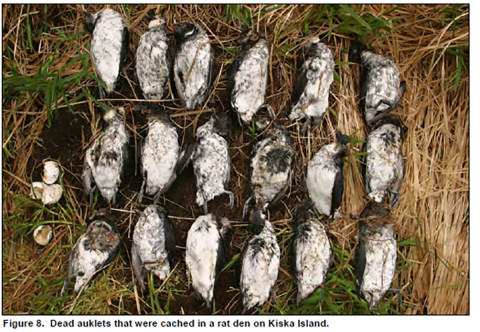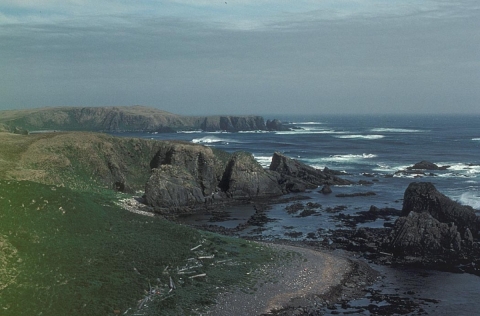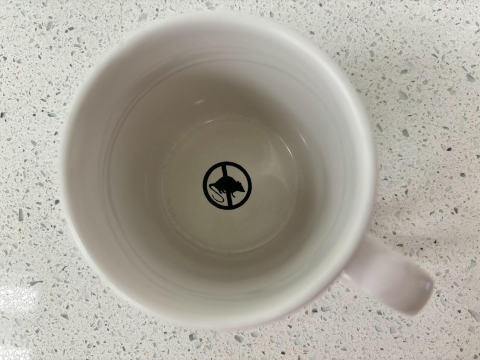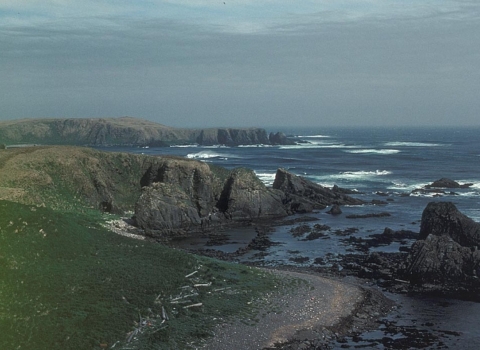This story is written by Lauren Cusimano, Communications Manager, Audubon Alaska, and originally appeared in On The Wire.
One of the most obvious distinctions between a rat-infested island and a non-rat-infested island is the sound.
"There's just a pronounced difference in visiting those islands that don't have rats … it's just like a cacophony of birds," says Stacey Buckelew, the Island Strike Team Biologist with the U.S. Fish and Wildlife Services’ (USFWS) Alaska Region Invasive Species Program. "It's just sound and smells and birds flying everywhere. And then you go to a rat Island, and it's just … like an eerie silence. There's just nothing there."
Buckelew is based in Homer, Alaska—a scenic city on the Kachemak Bay end of the Kenai Peninsula. It’s the headquarters of the 1980-established Alaska Maritime National Wildlife Refuge (Refuge)—a 1,000-mile-long, 5-million-acre region home to the Aleutian Islands. The Aleutians are comprised of 2,400 islands and headlands that the Unangan people have stewarded since time immemorial.
The problematic rat species in particular is the invasive Norway rat (Rattus norvegicus), or simply brown rat. (These are not to be confused with Alaska’s native rodents like muskrats, jumping mice, deer mice, voles, and lemmings.) And the victim here? Mainly 40 million nesting seabirds like auklets and puffins. To put that into perspective, there are approximately 50 million nesting seabirds in Alaska. So, it's a big chunk.
But hearteningly, rodents have been successfully removed from over 400 islands worldwide—including one in the Aleutians. And this fall, a government process is starting to continue eradication down the chain—essentially ending a centuries-long rat reign on four Aleutian Islands.
The History
For fans of the mystery genre, how rats got to the Aleutian Islands can be a "Murder, She Wrote"-level whodunnit.
"It is certain that Norway rats first reached the Aleutian islands from a shipwreck in the 1700s, but the details of the original spill, including the ship's flag, the location, and the exact year, are shrouded in the swirling fog of history," says Lauren Flynn, a Wildlife Refuge Specialist also with the Refuge.
Flynn says there are two strings of evidence to support that the first introduction occurred in a far western subgroup called the Rat Islands, a cluster just east of the Near Islands consisting of Kiska, Segula, Khvostof, Davidof, Amchitka, and Hawadax (formerly known as Rat Island, though more on that later).
"One evidence string I followed supports that the first recorded rat spill in the Aleutians was the Japanese ship Shinsho-maru in 1783 on Amchitka Island," Flynn says. Another 1778 record quotes the most likely Unungan inhabitants of Hawadax Island as saying that rats were only present there after a foreign ship was stranded there. However, she has not yet located any wreck stories from Hawadax. "So far the only available documentation I have located for wreckage in the Rat Island group prior to 1778 is on Kiska Island for a Russian fur vessel called the Kapiton that wrecked in 1758," she says.
Then of course the problem was exacerbated during World War II when American Navy ships were traveling along the Aleutian Chain, especially for four now-uninhabited islands that will be the focus of this story—Great Sitkin, Atux̂, Kiska, and Amchitka.
Buckelew says the pathway of introduction of rats to these four islands was most likely World War II because records from naturalist biologists visiting the islands didn’t report any rats prior. During WWII, however, all four islands were occupied by military forces and infrastructure was constructed. After that, of course, records of rats inhabiting these islands cropped up, meaning rats have been on the islands for close to 80 years.
Helena Schmitz is president, CEO, and founder of Atux̂ Forever, a nonprofit organization representing the Saskinax̂ Unceded Nation that was created to provide more trips to Atux̂ and nearby traditional homelands like Angatux̂, Samiya, Anvayaax̂, Alaid, and the surrounding smaller harvesting areas. They support environmental remediation and have a positive memorandum of understanding with the Refuge.
"We are hoping to hold both governments in WWII to remediate our islands back to their natural state before the war," Schmitz says. "It is a huge environmental injustice that the people who suffered the most from the war must clean up these messes."
How Are Rats an Issue?
"Rats are ranked within the top 100 of most damaging invasive species invasive species
An invasive species is any plant or animal that has spread or been introduced into a new area where they are, or could, cause harm to the environment, economy, or human, animal, or plant health. Their unwelcome presence can destroy ecosystems and cost millions of dollars.
Learn more about invasive species ," Buckelew says. Aside from the fact that "they do a ton of economic damage in places where there's human infrastructure" (e.g. chewing through wires, metal, and cement, and damaging structures), they have an appetite for seabirds.
"On the Aleutian Islands in particular and islands around the world, rats are predatory for ground-nesting species," Buckelew says.
Content warning, the way rats go about eating seabirds is gruesome. Rats actually "eat into the brains of the living birds, whose instinct to sit tight and protect their single egg overwhelms even pain and death," according to (our old friend) Scott Weidensaul’s "A World on the Wing" (Pages 271 to 277 if you’re curious). Yes, that means a bird is often eaten alive. And in addition to the ultra-fresh brains and eyes of nesting seabirds, rats also go for eggs and chicks.
And seabirds are the perfect victim. They have evolved to nest in burrows, on the ground, or on the ledge of cliffs across this chain of land masses that were once free of predators like rats, foxes, rabbits, and cows. So "without natural instincts to escape predation, many island bird populations plummeted or were entirely extirpated by rats and foxes that feed on adult birds and chicks," reads a USFWS informational webpage on Rat Free Aleutians. That should answer any question or comeback of, "Why can’t the birds just fly away?"
On with the horror show. After a rat feeds, it caches the bodies of their victims, forcing some visiting biologists to discover mass graves containing dozens if not hundreds of seabird carcasses.
To stick with the eco-horror genre for a second more, rats are also quick to reproduce. In the appropriately dramatic words of the USFWS, "rat spills are forever" and "can be far worse than oil spills. Oil degrades over time while rats multiply, and multiply...and multiply!"
Buckelew says rats are also predatory, "so they feed on native wildlife and plants, and have the ability to alter entire ecosystems." Buckelew’s colleague, Refuge manager Steve Delehanty, said in a 2022 Science Friday report, "The rats are like an oil spill that keeps on spilling, year after year."
Dr. Ian L. Jones, a professor in the Department of Biology at Memorial University of Newfoundland, is quoted in the 2012 book "Rat Island: Predators in Paradise and the World's Greatest Wildlife Rescue" as saying, "The number of seabirds that are being killed by rats each year are more than what were killed by the Exxon Valdez oil spill." And one more detail meant to send a chill up your spine—rats are excellent swimmers.
This all contributes to seabirds being one of the most threatened bird groups on the planet.
"We hope that protecting birds means protecting the whole ecosystem as everything is connected," Schmitz says. "Culturally, our Sovereign Nation is a bird people—we are the bird people. There are fewer birds there than there were historically."
She’s right, especially when it comes to seabirds. About 47% are experiencing population declines. Then, 28% are globally threatened and 5% are considered critically endangered.
The causes of declines? Human activities and invasive species. Approximately 30% of seabirds are at risk of extinction from invasive species impacts.
"Invasive species, to us," Schmitz says, "Symbolize the intersection of colonizers and the ecosystems they affect."
Rat Island No More
Things were bleak until Hawadax (pronounced how-AH-thaa). That might make more sense when you hear its former name: Rat Island.
The former Rat Island is a 10-square-mile, 6,869-acre blip so badly infested by the invasive Norway rat it just assumed the obvious moniker. And if 10 square miles don’t sound like a big deal, keep in mind that "Although islands account for just 6% of the world's landmass, they are home to approximately 20% of the world's bird and plant species."
The Refuge and its partners have worked for more than 60 years to remove nonnative predators, restoring more than 1 million acres across nearly 50 islands since the 1940s. But a bright spot is certainly Hawadax. In October of 2008, the Refuge and partners like Island Conservation and The Nature Conservancy launched a campaign to eradicate then Rat Island "using an aerial broadcast of grain pellets containing rodenticide." They returned in 2010 to see how it went, and not a single rat was detected. Eradication was declared victorious.
But not all was perfect. There were higher-than-expected mortalities of Bald Eagles and Glaucous-winged Gulls during the process.
"There are a lot of lessons learned coming out of that incident," Buckelew says. "Fortunately, eagles and gulfs did recover within five years on the island, but the way that we will handle mitigation for nontarget species will be different in the future."
Then, in 2012, the U.S. Board on Geographic Names officially renamed Rat Island to Hawadax Island. This is an Unangan word meaning "those two over there," which, according to The Nature Conservancy, describes the island’s two noticeable knolls. "This name is further supported by attestations recorded in 1840 and again in 1950-1952. The name is still used by speakers in the native village of Atka today."
Karen Pletnikoff of the Aleutian Pribilof Islands Association is the one who petitioned the U.S. Board on Geographic Names, writing, "Since the island is now rat-free, an appropriate Unangas/Unangan name should be restored to reflect both the true history of the island and celebrate the success of removing invasive species from essential habitat. Resources show that the most historic Unangas/Unangan name for the island was ‘Hawadax.'"
Now, Hawadax is a poster island for two reasons. One, the rats never returned. And two, the birds did.
"I think what was most noticeable within two years of rat eradication was the recovery of the songbird or the passerine populations," Buckelew says. "We saw a recovery on the order of 200% or greater in those years of Winter Wrens, Song Sparrows, Gray-crowned Rosy-Finches, Snow Buntings—things that may not seem exciting because they're pretty common within Alaska, but they occurred in very low numbers on the islands." Rock Sandpiper, Pigeon Guillemot, Common Eider, and Red-faced Cormorant were also noted to be successfully nesting on the island.
But what’s more exciting is that Song Sparrows were not detected previous to eradication, even though about 600 person-hours were done to survey for those species. With the simple release of predation pressure, they were able to recolonize. Then shorebirds and Black Oystercatchers were first documented as breeding on the island within five years post-eradication, as were Tufted Puffins and Leach's Storm-Petrel.
"So we definitely saw some signs of immediate recovery of songbirds and probably more passive and long-term recovery of shorebirds and seabirds on the island," Buckelew says.
In time, this part of the Aleutian Chain could one day resemble the nearby (in the grand scheme of things) Pribilof Islands. Donald Lyons, Director of Conservation Science with the National Audubon Society’s Seabird Institute, recently described to AP what it’s like being there, watching clouds of auklets—"tens of thousands, hundreds of thousands, perhaps millions of birds in the air at a given time"—return to their colonies in the evening. "It’s just the abundance of wildlife that we hear stories or read historical accounts of, but really seldom see in kind of our modern age," Lyons says. "And so it really is a place where I’ve felt the wonder, the spectacle of nature."
How Hawadax Can Happen Again … and Again
Again, the Refuge is in the early stages of planning for rat eradication on Great Sitkin, Atux̂, Kiska, and Amchitka. Buckelew says these four islands are the current focus because they are uninhabited and the likelihood of the reintroduction of rats is low because there are no boat docks or human habitation.
Schmitz with Atux̂ Forever says the traditional stewards of these lands and oceans have not been able to return to our homelands since 1942. "We do not have any harvesting in the region, which is a human right that was taken away from us," she says. "We would like to have a normal Alaskan fish camp in our traditional homelands, so we can be reconnected to our land and our subsistence way of life."
So now comes the federal process.
"Because we operate on federal lands, our actions have to be proposed under the National Environmental Protection Act or NEPA, and vetted through the public and agencies in the environmental assessment," says Buckelew. "So that's where we are currently for proposed rat eradication on four islands."
This Refuge team at USFWS has a strategic approach to this that will be a mosaic of coordinated actions. Those are:
- Biosecurity: The Refuge and partners developed and implement strict protocols aimed at preventing unintentional releases of invasive species.
- Restoration: The Refuge and partners are currently in the process of assessing the possibility of rat removal on four Aleutian Islands—Great Sitkin, Amchitka, Kiska, and Atux̂.
- Communication: Engage with stakeholders to gain local knowledge, gather input, provide updates, and more, including participating in StopRats.org activities.
- Monitoring and Rapid Response: Planned rapid response mechanisms are in place should a rat spill, or other invasive species infestation occur.
Side note: If biosecurity is a new term for you, Flynn defines it as a practice that protects one living thing or things from another living thing or things. "At Alaska Maritime National Wildlife Refuge, we practice ecological biosecurity," she says. "For example, we clean our footwear before visiting an island to make sure we are not introducing seeds, soils, or disease carried in fecal matter to the island's ecosystem."
As of September 23, 2024, a notice of intent has been dropped to prepare an environmental impact statement (EIS) for the eradication of invasive rats on Great Sitkin, Atux̂, Kiska, and Amchitka islands—the first step in an EIS timeline that will span from now to winter 2026.
These things usually come with a purpose and need statement, which is:
- Purpose: Eliminate the impacts of invasive rats on native species and restore natural island ecosystems on Great Sitkin, Amchitka, Kiska, and Atux̂ Islands.
- Need: Invasive rats on Great Sitkin, Kiska, Amchitka, and Atux̂ Islands in the Aleutian archipelago have negatively impacted native wildlife and altered natural ecosystem functions on the islands.
The next step at the time of publication is for public scoping meetings to be held on Wednesday, October 9, 2024, from 6 to 8 p.m. in the BP Energy Center at 1014 Energy Court in Anchorage. This informational session will be crawling with USFWS staff, volunteers, and partners. There will be a presentation, written materials, banners with the proposed alternatives around the room, and people available to answer questions or engage in dialog. There will also be a recorder there, so attendees may record their comments there and then, or submit written comments later.
The five proposed alternatives that will be presented at the public scoping meeting for this EIS are:
- Alternative 1: No action
- Alternative 2: Rat Eradication Primarily Using Bait Pellets Containing the Rodenticide Brodifacoum
- Alternative 3: Rat Eradication Primarily Using Bait Pellets Containing the Rodenticide Diphacinone
- Alternative 4: Rat Eradication Using Emerging Genetic Biocontrol Technology
Alternative 5: Rat Eradication Primarily Using Bait Pellets Containing the Rodenticide Norbormide
"We hope to put forward these ideas, our proposed alternatives for eradication, to the public and agencies and local communities within the Aleutian Islands to get their input, to gather ideas, and ensure that we're not overlooking anything in preparation of the EIS," Buckelew says.
A public scoping period will run till November 4, 2024, after which USFWS will analyze the public scoping comments and prepare a summary report. Preparing the draft EIS will take up 2025, and will be subject to a most likely 45-day public comment period in spring 2026. Public meetings on the draft EIS will be held, followed by publication of a final EIS in fall 2026, and a Record of Decision released in winter 2026.
Right now, Great Sitkin would be the first island for rat removal and the best-case scenario for this EIS process would be for the USFWS to be on the ground with a rat ratification operation within a five to 10-year time frame.
Could the Refuge’s Future Be Rat-Free?
Though rats and other invasive species have been ravaging the Aleutian Islands and many other parts of the world for centuries, they haven’t driven out all the native species … yet. But if they do, "the entire natural ecological order on the islands from nutrients, to plants, and birds" will be disrupted. The food web on these islands will remain imbalanced, and some species will (and have) be wiped out, never to return as long as rats are there. Remember the eerie silence?
Keep in mind, we’re still a ways from fully eradicating Great Sitkin, Atux̂, Kiska, and Amchitka islands. Eradication is a one-time action that happens island by island with tons of time in between, anywhere from five to 20 years. Large, remote islands are also a costly operation, running about $15 million per island.
But it’s a start, especially for uninhabited islands. There are about 12 rat-infested islands now, meaning after a (hopefully) successful eradication on these four, about eight or so would remain in need of rat removal. This means we can one far-off day move onto habited islands, one with people and boat docks. That’s a trickier situation, seeing as nearly 3,000 ships pass through the Aleutians on the Great Circle shipping route between Asia and North America on an annual basis. The average is about two shipping mishaps a year, meaning a "rat spill" could be bound to happen. But it’s still the plan.
"I think the big audacious goal would truly be rat-free Aleutians on uninhabited and habited islands. It'd be nice to just have this entire archipelago where rats don't exist and habitat is open for the native plants and wildlife that live there," says Buckelew. "Hopefully, that's a tangible goal. I think that it is."
And eradication tools may evolve during this time, making new technologies available over the life of this EIS. This could alter the timeline. Buckelew says it’s common now to use an anticoagulant rodenticide, though it can have some adverse impacts like with the Bald Eagles on Hawadax. But a hope would be to use emerging rodenticides that may be even more effective.
"A vision would be having an alternative to those rodenticides available that have the same efficacy as we see with the second-generation anticoagulants, and our EIS will be proposing a rodenticide that's an experimental phase. It's called Norbormide and it is Rattus-specific. It's a vasoconstrictor versus anticoagulant, so it works on rats but it doesn't kill things like birds and fish that may eat it," Buckelew says. "And so if we can continue to invest in new research and development and show the efficacy of those, I think that gives us even more tools under our belt to help us achieve that goal in the future."
And sure, the future seems far off, but there’s so much we can do in the meantime.
What You Can Do
First, be sure to attend the public scoping meeting in Anchorage on Wednesday, October 9, 2024, from 6 to 8 p.m. at the BP Energy Center at 1014 Energy Court in Anchorage.
You can also just follow the law. It’s illegal to own rats as pets in Anchorage (and if you're wondering who would own rats as pets, full disclosure, I had two rats as pets as a kid in Arizona—Tommy Boy and Princess). As for the rest of Alaska, the law only allows white rats in the state as pets. But for the love of seabirds, if you do own a pet rat, don't just release it into the wild.
You can also report rats to the Alaska Department of Fish and Game by phoning the Invasive Species Hotline at 1-877-INVASIV (2748), emailing dfg.dsf.InvasiveSpecies@alaska.gov, or going online. Finally, you can memorize all the essential information you need to stop rats at—you guessed it—StopRats.org.
But keep in mind, there will hopefully be opportunities to support further environmental remediation in future.
"There is an urgent need in our region and rat eradication is the right step forward, but afterward, there is a lot more work to be done," Schmitz says. Groups like Atux̂ Forever have been fighting for human rights from environmental injustices since WWII, yet other environmental issues have piled up in the decades since.
"The surrounding small islands are like nets for catching plastic and trash from the ocean. Climate change is not studied in our region primarily because there are no traditional stewards that live there," Schmitz says. "However, we are hopeful more environmental remediation will eventually happen in our traditional homelands."


